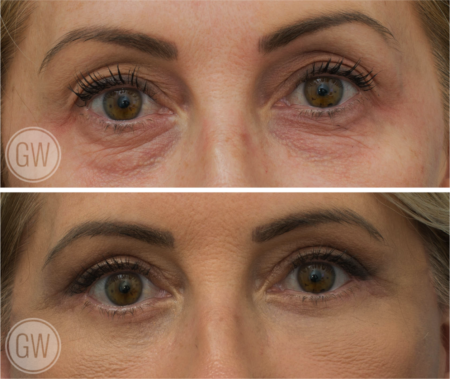
14 May What are Hooded Upper Eyelids? – Causes & Options
Understanding the Causes and Treatment for Hooded Eyelids
Are you tired of worrying about the appearance of your hooded upper eyelids? Do you find yourself avoiding certain makeup looks or feeling like you look tired even when you’re well-rested? Well, you should know that you’re not alone. Hooded upper eyelids are a cosmetic concern for many people, and they can be caused by a variety of factors. The good news is that there are effective options that can help alleviate the appearance of hooded upper eyelids for good. In this blog, we’ll explore the causes of hooded upper eyelids and share some of the options to help you achieve a more refreshed appearance. From lifestyle changes to more advanced cosmetic procedures, we’ll cover what you need to know to make an informed decision.
Take our quiz, and find out if you are ready for surgery
Perth Specialist Plastic Surgeon Dr Guy Watts provides a comprehensive approach to addressing hooded eyes, helping patients achieve a more refreshed appearance. Through personalised consultations, he carefully assesses each patient’s unique needs and concerns before recommending the most suitable treatment option, whether it be non-surgical interventions or surgical procedures such as blepharoplasty.
Causes of Hooded Upper Eyelids
Understanding the anatomy of the eye is essential to know what causes hooded upper eyelids. The eyelids are composed of thin skin and a layer of muscle that lifts and lowers the eyelid. The skin on our eyelids is the thinnest on our body and is prone to laxity due to ageing, sun damage, and other factors. Hooded upper eyelids occur when the skin on the upper eyelid hangs, making the eyelid appear smaller and less defined. There are several factors that can contribute to hooded upper eyelids, including the following:
Ageing
Ageing is the primary cause of hooded upper eyelids. As we age, our skin loses elasticity and firmness, making it more prone to laxity. This loss of elasticity is particularly evident in the delicate skin around the eyes. The muscles that support the eyelids also weaken with age, further contributing to the hanging effect. These factors can result in significant hooding of the upper eyelids, making the eyes appear smaller.
Genetics
Genetics also play a role in the development of hooded upper eyelids. If your parents or other family members have hooded upper eyelids, you may be more likely to develop them as well. This is because the shape of our eyes and the thickness of our skin are largely determined by our genes. While we can’t change our genetics, there are still steps we can take to reduce the appearance of hooded upper eyelids.
Lifestyle factors
Lifestyle factors such as sun exposure, smoking, excessive use of alcohol, and poor nutrition can also contribute to the development of hooded upper eyelids. Sun damage can cause the skin to lose elasticity and firmness, while smoking can accelerate the ageing process and contribute to skin ptosis. A diet lacking in essential nutrients can also affect the skin’s health and contribute to premature ageing.
Download Dr Watts’ Ultimate Guide to Blepharoplasty
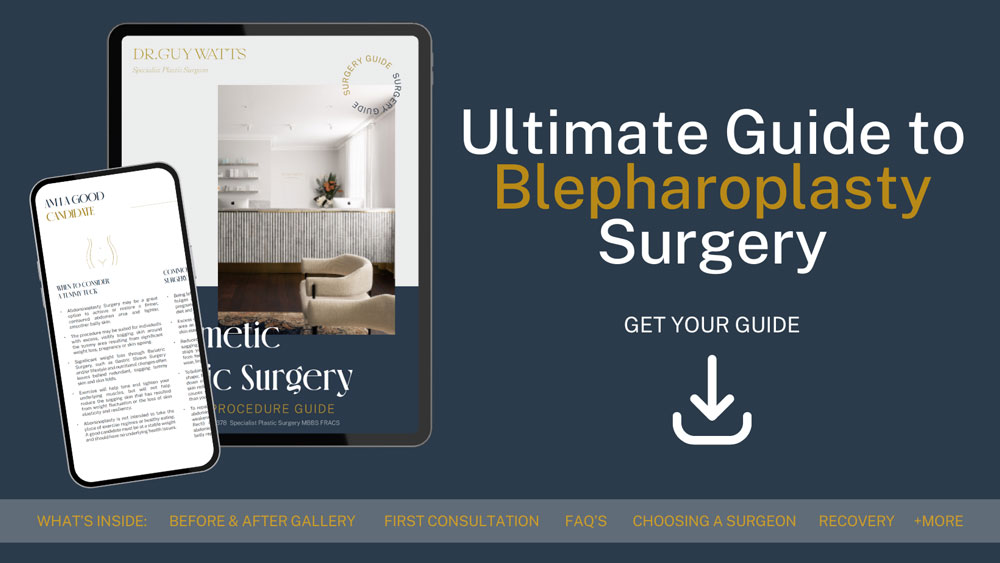
Non-Surgical Options for Hooded Upper Eyelids
If you’re looking for non-surgical options for hooded upper eyelids, there are several options available. These options can help reduce the appearance of hooding and give your eyes a more refreshed look. Here are some non-surgical options for hooded upper eyelids:
Eye creams
Eye creams are a popular non-surgical option for hooded upper eyelids. Look for eye creams that contain ingredients like retinol, vitamin C, and caffeine, which can help firm and tighten the skin around the eyes. These ingredients can also help reduce the appearance of fine lines and wrinkles, giving the eyes a more refreshed look.
Wrinkle Treatments
Wrinkle Treatments are a popular cosmetic treatment that can help reduce the appearance of hooded upper eyelids. The treatment works by relaxing the muscles that cause the eyelids to drop, giving the eyes a more lifted and refreshed appearance. The effects of wrinkle treatments usually last for several months and will need to be repeated to maintain the results.
Laser resurfacing
Laser resurfacing is a non-invasive option for hooded upper eyelids. This procedure involves using a laser to remove the top layer of skin on the eyelids, promoting the growth of new skin. Laser resurfacing can help tighten and firm the skin around the eyes, giving them a more refreshed appearance.
Eyelid Volumising Treatments
Eyelid volumising treatments are a non-surgical option that can provide a temporary change for individuals seeking to alleviate hooded eyes. This treatment involves injecting a substance into targeted areas around the eyelids to add volume and support to the skin. By strategically placing the substance, a skilled practitioner may be able to subtly lift the upper eyelid, reducing the appearance of hooding to help refresh the patients appearance. Although the results are not as long-lasting as surgical interventions like blepharoplasty, eyelid volumising treatments can be an effective option for those who prefer a less invasive approach.
Photo disclaimer: Each surgical procedure produces unique outcomes influenced by factors such as body composition, skin tone, laxity, age, and genetics. The before-and-after photographs displayed are of actual patients who have consented to having their images displayed and are provided for informational purposes only. These outcomes are specific to the individuals shown and may not be representative of all patients. Surgical procedures carry risks, and results may vary. A consultation with your surgeon will provide more personalised information about potential outcomes and risks.
Surgical Options for Hooded Upper Eyelids
If non-surgical options aren’t providing the results you’re looking for, there are several surgical options available for hooded upper eyelids. These procedures can help lift and tighten the skin around the eyes, giving you a more refreshed appearance. Here are some surgical options for hooded upper eyelids:
Blepharoplasty
Blepharoplasty, also known as eyelid surgery, is a popular surgical treatment for hooded upper eyelids. This procedure involves removing excess skin and fat from the eyelids, giving the eyes a more lifted and defined appearance. Upper Lid Blepharoplasty may be performed under local or general anaesthesia and Lower Lid Blepharoplasty is be performed under general anaesthetic.
Brow lift
A brow lift is another surgical option for hooded upper eyelids. This procedure involves lifting and tightening the skin and muscles of the forehead, which can help lift the eyebrows and reduce the appearance of hooded upper eyelids. Brow lifts are performed under general anaesthesia and can be done using a variety of techniques, including endoscopic and open brow lifts.
Recovery and Aftercare for Eyelid Surgery
If you decide to undergo eyelid surgery or any other surgical treatment for hooded upper eyelids, it’s important to understand the recovery and aftercare process. You’ll likely experience some swelling and bruising after surgery, which can take several weeks to fully subside. It’s important to follow your surgeon’s instructions for aftercare, which may include using cold compresses, keeping your head elevated, and avoiding strenuous activity for several weeks.
Prevention Tips for Hooded Upper Eyelids
Prevention over treatment is generally preferred when it comes to hooded upper eyelids. While some factors, such as genetics, are out of our control, there are still steps you can take to reduce the appearance of hooding. Here are some tips for preventing hooded upper eyelids:
- Protect your skin from the sun: Sun damage is a major contributor to premature ageing and skin laxity. Protect your skin from the sun by wearing sunscreen and avoiding prolonged sun exposure, especially during peak hours.
- Quit smoking: Smoking accelerates the ageing process and contributes to the appearance of excess skin. Quitting smoking can have a significant impact on the health and appearance of your skin, including the fine skin around your eyes.
- Eat a nutritious diet: A diet rich in essential nutrients can help optimise the appearance of your skin. Focus on eating plenty of fruits, vegetables, whole grains, and lean protein to support the health of your skin.
- Avoid excessive consumption of Alcohol: Excess Alcohol can cause fluid retention and puffiness around the eyes, which results in stretching of the tissue.
Hooded upper eyelids can be a frustrating cosmetic concern, but there are effective options available. Remember to take steps to prevent the development of hooded upper eyelids, such as protecting your skin from the sun and maintaining a active lifestyle.
FAQs about Causes and Options for Hooded Upper Eyelids
How do you remove hooded upper eyelids?
- There are a few ways to address hooded upper eyelids, ranging from cosmetic treatments to surgical procedures.
- Non-surgical treatments may include chemical peels, laser resurfacing, or volumising treatments to refresh and tighten the skin around the eyes.
- Blepharoplasty is a surgical procedure that involves removing excess skin, muscle, and/or fat from the upper eyelids.
What causes upper eyelid hooding?
- Upper eyelid hooding can be caused by several factors such as ageing, genetics and lifestyle.
- As people age, skin loses elasticity and muscles around the eyes weaken, which can lead to skin laxity (excess, loose skin) on and around the eyelids.
- Some people are genetically predisposed to have hooded eyelids.
- Prolonged sun exposure, smoking, and poor diet can also contribute to skin ageing and eyelid hooding.
Can you reverse hooded eyelids?
- Depending on the severity and cause of hooded eyelids, certain treatments may help reduce the appearance of hooding.
- Non-surgical treatments like chemical peels or laser resurfacing can provide temporary changes, while surgical options like blepharoplasty can provide more long-lasting results.
Do hooded eyes get worse with age?
- Yes, hooded eyes tend to get worse with age. The skin around the eyes is one of the first areas to show signs of ageing due to a loss of elasticity. Older individuals who have hooded eyes may experience more significant effects of ageing because their eyes are already surrounded by more skin.
Further Reading about Face Surgery with Dr Guy Watts
- Read Dr Guy Watts’ Face and Neck Lift Page
- Read Dr Guy Watts’ Brow Lift Page
- Read Dr Guy Watts’ Blepharoplasty Page
- Read Dr Guy Watts’ Facial Augmentation Page
- Read Dr Guy Watts’ Rhinoplasty Page
- Read Dr Guy Watts’ blog about Sunken Eyes – Causes and Options
- Read Dr Guy Watts’ blog about Recovery After Lower Blepharoplasty
Medical References about Hooded Eyelids
About Dr. Guy Watts – MED0001539378
FRACS (Plas) – Specialist Plastic Surgeon In Perth WA
Dr. Guy Watts is a Specialist Plastic Surgeon (AHPRA MED0001539378) with an extensive career that spans across renowned plastic surgery clinics worldwide. His experience has been honed through invaluable experiences at esteemed establishments such as the New York Eye and Ear Infirmary and the renowned Pitanguy Clinic in Brazil.
Having collaborated with the foremost cosmetic plastic surgeons on a global scale, Dr. Watts has chosen to return to Perth after a 17-year journey of intensive training and invaluable professional experience to bring the latest practices and technology in cosmetic plastic surgery to his patients.
Dr. Watts is a Fellow of the Royal Australasian College of Surgeons (FRACS) and a Member of the Australian Society of Plastic Surgeons (ASPS), Australasian Society of Aesthetic Plastic Surgeons (ASAPS) and the International Society of Aesthetic Plastic Surgeons (ISAPS).
Read about the potential Risks and Complications of Surgery
Read the Patient Information and Resources
About CLINISPA
Clinispa is Dr Watts’ bespoke medical clinic performing Cosmetic Aesthetic treatments. At Clinispa, we offer advanced clinical treatments in a luxurious and calming environment, tailored to support your skin’s health and appearance.
Clinispa aesthetic services are performed by Dr Guy Watts’ nursing professionals, who have a passion for and solid understanding of facial aesthetics.
All Clinispa clients are considered individually, with a personalised treatment plan consisting of advanced scientific approaches to cosmetic aesthetics. We incorporate innovative technologies in conjunction with superiorly formulated skin care.
For more information about the full range of Clinispa Aesthetic of Cosmetic Treatments visit the Clinispa website







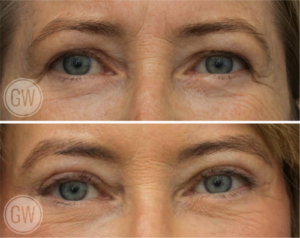
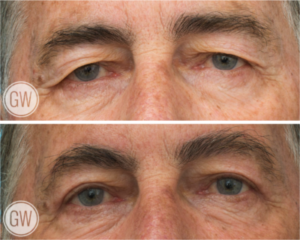
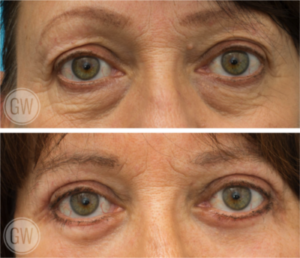

Sorry, the comment form is closed at this time.